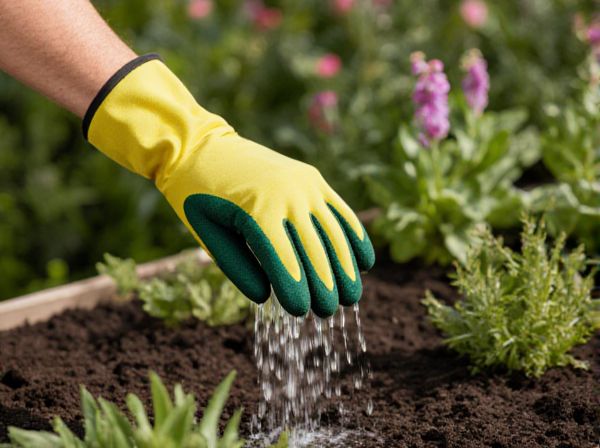
Self-watering bed vs Manual watering Illustration
Self-watering raised beds maintain consistent moisture levels by using a reservoir that supplies water directly to plant roots, reducing water waste and minimizing the need for frequent manual watering. In contrast, manual watering requires regular attention to avoid overwatering or drought stress, demanding more time and effort from the gardener. Choosing a self-watering bed enhances plant health by providing steady hydration and improves water efficiency in garden maintenance.
Table of Comparison
| Feature | Self-Watering Raised Bed | Manual Watering Raised Bed |
|---|---|---|
| Water Efficiency | High - Conserves water with automatic soil moisture regulation | Moderate - Dependent on user frequency and amount |
| Maintenance | Low - Requires occasional reservoir refilling | High - Needs daily or frequent watering |
| Plant Health | Consistent moisture improves growth and reduces stress | Variable moisture can cause over or underwatering stress |
| Setup Complexity | Moderate - Includes water reservoir and wick system | Low - Standard raised bed with soil |
| Cost | Higher initial investment due to system components | Lower initial cost, no special components needed |
| Ideal Use | Busy gardeners or water-scarce areas | Gardens with easy water access and regular attention |
Understanding Self-Watering Raised Beds
Self-watering raised beds utilize a built-in reservoir that supplies water directly to plant roots, promoting consistent moisture levels and reducing water waste compared to manual watering. These systems minimize the risk of overwatering or underwatering, enhancing plant health and growth efficiency by maintaining optimal soil hydration. Gardeners benefit from less frequent watering tasks, making self-watering beds ideal for busy schedules or water conservation efforts.
How Manual Watering Systems Work
Manual watering systems in raised beds involve directly applying water using hoses, watering cans, or drip emitters controlled by the gardener, offering precise control over the amount and frequency of water delivered to plants. These systems require regular monitoring and adjustment based on soil moisture levels, weather conditions, and plant water needs to prevent under or overwatering. Manual watering promotes targeted hydration, reduces water waste, and enables immediate response to the specific requirements of different crops within the raised bed.
Key Benefits of Self-Watering Beds
Self-watering raised beds optimize water efficiency by providing consistent moisture directly to plant roots, reducing water waste and promoting healthier growth. They require less frequent watering, saving time and labor compared to manual watering methods. This system also minimizes the risk of overwatering and root rot, ensuring better plant health and higher yields.
Pros and Cons of Manual Watering
Manual watering in raised beds allows precise control over water distribution, targeting specific plants' needs and conserving water by avoiding overwatering. However, it demands consistent effort and time, which can be challenging during busy schedules or extended absences. Inconsistent watering can lead to plant stress, uneven growth, and increased susceptibility to pests and diseases compared to self-watering systems.
Water Efficiency Comparison
Self-watering raised beds utilize a reservoir system that consistently supplies moisture to plant roots, reducing water waste through evaporation and runoff. In contrast, manual watering often leads to uneven moisture distribution and higher water consumption due to overwatering or missed spots. Studies show self-watering beds can improve water efficiency by up to 50%, making them ideal for sustainable gardening practices.
Maintenance Requirements Explored
Self-watering raised beds reduce maintenance by automatically supplying water through a reservoir, minimizing the need for frequent manual irrigation. Manual watering demands consistent attention to soil moisture levels, increasing labor and the risk of over- or under-watering plants. Choosing self-watering beds optimizes water efficiency and lowers long-term upkeep in garden management.
Suitability for Different Plant Types
Self-watering raised beds offer consistent moisture ideal for moisture-loving plants such as tomatoes, peppers, and leafy greens, promoting healthy root development and reducing watering frequency. Manual watering suits plants with varied moisture needs like succulents or herbs, allowing precise control over water application and preventing overwatering. Understanding each plant's tolerance to soil moisture helps optimize growth and prevents root diseases in both systems.
Cost Considerations: Initial and Long-term
Self-watering raised beds typically require a higher initial investment due to built-in reservoirs, wicking materials, and irrigation components, while manual watering beds incur lower upfront costs but demand ongoing purchase of hoses or watering cans. Long-term expenses for self-watering beds often decrease because they reduce water usage and labor, promoting efficiency and sustainability. Manual watering may result in increased water bills and time costs, especially in larger gardening spaces with frequent watering needs.
Climate and Location Factors
Self-watering raised beds offer consistent moisture levels ideal for arid and hot climates where rapid soil drying occurs, reducing the need for frequent irrigation. Manual watering provides flexibility in regions with variable rainfall or cooler temperatures, allowing tailored moisture control based on daily weather conditions. Understanding local climate patterns and soil drainage is crucial when choosing between these systems to optimize plant health and water efficiency.
Making the Right Choice for Your Garden
Self-watering raised beds use a reservoir system to deliver consistent moisture directly to plant roots, reducing water waste and promoting healthier growth compared to manual watering. Manual watering requires regular attention and can lead to uneven soil moisture, potentially stressing plants and reducing yields. Choosing between self-watering and manual watering depends on your garden's size, available time, and water conservation goals.
Self-watering bed vs Manual watering Infographic

 gardendif.com
gardendif.com